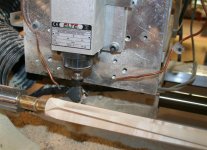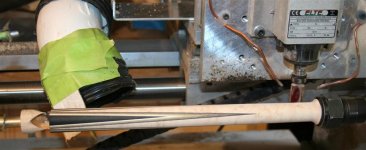I have a milling machine set up to cut points using a double angle side cutter. In my mind, it seems that I should only use climbing cuts as a conventional cut might tend to tear out the workpiece. Further, I only climb up out of the groove rather than climb down toward the A joint area.
Yesterday I watched a video on cutting points where a deep rough conventional cut from A-joint to main-joint was followed by a fine climbing cut back down into the groove. This is much faster than what I do and yielded good results on the video, but I'd like to better understand the error of my ways.
How do you guys do it?
Yesterday I watched a video on cutting points where a deep rough conventional cut from A-joint to main-joint was followed by a fine climbing cut back down into the groove. This is much faster than what I do and yielded good results on the video, but I'd like to better understand the error of my ways.
How do you guys do it?

